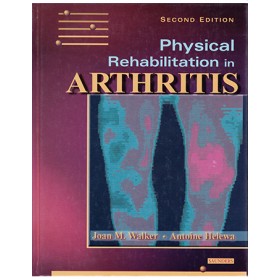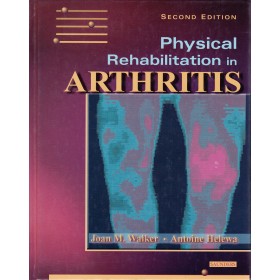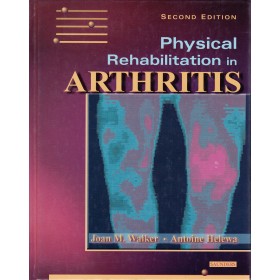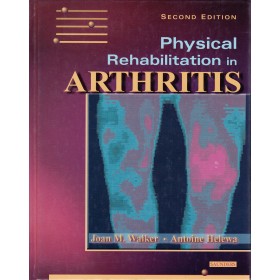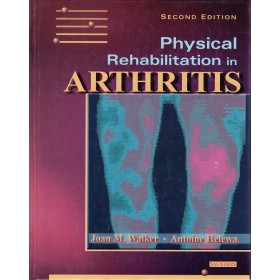Details
Share a Course: Physical Rehabilitation in Arthritis: Module 2 (Electronic Download)
SKU: 717SE
by Joan M. Walker, PhD, MA, Dip TP, BOT, Certifs in PT (NZ)
and Antoine Helewa, MSc (Clin Epid), PT
Do you already have access to the reading materials and only need the testing materials? Are you planning to Share A Course with someone else who already has the reading materials?
This course is offered in cooperation with Elsevier Science and utilizes the textbook “Physical Rehabilitation in Arthritis”c2004. This exciting book is devoted to the treatment of patients with arthritis and rheumatic diseases. Textbook discusses epidemiology, diagnostic information, pharmacology, surgical interventions, and management and rehabilitation issues. This course is essential to all therapists dealing with geriatrics!
Module 1 covers history of arthritis, epidemiology, pathophysiology, diagnosis and medical management of conditions with arthritis and assessment of joint disease
Module 2 covers pharmacology, surgical interventions, juvenile rheumatoid arthritis, rheumatoid arthritis and ankylosing spondylitis
Module 3 covers osteoarthritis, chronic muscle pain syndromes, patients with multiple joint involvement, splinting, orthotics, psychosocial factors, community-based physical rehabilitation and special topics in clinical research.
Order this product and it will be available to you immediately after purchase for electronic download in the “My Downloads” section of your account after you have logged in. The download files will require Adobe Acrobat Reader to open. If you do not have Adobe Acrobat installed, you may download it at no charge from Adobe.com.
Course Length: 7.0 contact hours
Instructional Level: Beginner/Intermediate
This package includes only the testing materials for Module 2 and not the required reading materials.
Physical Rehabilitation in Arthritis: Module 2
Course Goals:
This course is intended to instruct the student through self-paced study of the physical rehabilitation and treatment of patients with arthritic diseases.
Student Objectives:
At the end of this course the student will be able to:
1. Identify 5 reasons physical and occupational therapists should be familiar with an arthritic client’s drug regimen.
2. Identify considerations for therapists when treating patients taking: acetaminophen, NSAIDs, salicylic acid derivatives, corticosteroids, antimalarials, gold compounds, penicillamine, sulfasalazine, methotrexate, azathioprine, leflunomide, etanercept, infliximab, colchicine and allopurinol.
3. Recognize warning signs requiring referral to a physiciain for patients taking: acetaminophen, NSAIDs, salicylic acid derivatives, corticosteroids, antimalarials, gold compounds, penicillamine, sulfasalazine, methotrexate, azathioprine, leflunomide, etanercept, infliximab, colchicine and allopurinol.
4. Identify 6 factors that compromise surgical intervention.
5. Identify factors to be considered in the decision of whether to intervene surgically in the management of an arthritic patient.
6. Identify the purpose of debridement, osteotomy, arthrodesis, arthroplasty, synovectomy, bursectomy, tendon transfers, nerve decompression and nodule resection surgeries.
7. Identify the general priority of surgical procedures.
8. Identify common surgical procedures of the spine, shoulder, elbow, wrist, hand, hip and knee for arthritic patients.
9. Identify the 6 subtypes of Juvenile Idiopathic Arthritis
10. Identify the manifestations of Juvenile Rheumatoid Arthritis
11. Identify the disease course and prognosis for pauciarticular, polyarticular and systemic juvenile rheumatoid arthritis
12. Identify assessment approaches for the child with juvenile rheumatoid arthritis
13. Identify potential impacts on the family of a child with juvenile rheumatoid arthritis.
14. Identify patterns of contracture and restriction that can be clinically present in patients with juvenile rheumatoid arthritis
15. Identify values of hydrotherapy when treating patients with juvenile rheumatoid arthritis
16. Identify 7 joints that are particularly susceptible to flexion contractures in the juvenile rheumatoid arthritis patient.
17. Identify characteristics of a “good splint”
18. Identify methods to enhance splint-wearing adherence in the juvenile rheumatoid arthritis patient
19. Identify protocols for stretching, muscle strengthening, and aerobic training for the juvenile rheumatoid arthritis patient.
20. Identify barriers to patient adherence of treatment plans and goals with the juvenile rheumatoid arthritis patient.
21. Identify potential barriers and adaptation strategies for the juvenile rheumatoid arthritis patient’s school environment.
22. Identify 5 objectives of physical and occupational therapy in the management of patients with rheumatoid arthritis.
23. Identify 8 general principles in the physical rehabilitation of rheumatoid arthritis.
24. Identify the effects of heat or cold modalities on the rheumatoid arthritis patient.
25. Identify the effects of heat/cold packs, paraffin wax, short-wave diathermy and microwave diathermy, ultrasound, TENS, interferential currents and electrical muscle stimulation on rheumatoid arthritis patients.
26. Identify 6 objectives of therapeutic exercise in the treatment of patients with rheumatoid arthritis.
27. Identify 2 PNF techniques that can be effective in mobilizing a rheumatoid arthritic joint with restrictions.
28. Identify 5 principles that should be considered in planning a strengthening exercise program for a rheumatoid arthritis patient.
29. Identify the difference between isolated movements and mass patterns with therapeutic exercise and identify the preferred technique in treating rheumatoid arthritis patients.
30. Identify when isometric or isotonic exercises should be used in the therapeutic exercise program of a rheumatoid arthritis patient.
31. Identify the difference between low back pain and ankylosing spondylitis.
32. Identify common functional activities that a patient with ankylosing spondylitis may have problems performing.
33. Identify indications for the use of PNF when treating a patient with ankylosing spondylitis.
34. Identify key musculature for stretching and strengthening when treating a patient with ankylosing spondylitis.
35. Identify key exercises for the treatment of ankylosing spondylitis.
